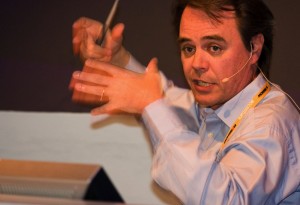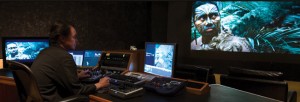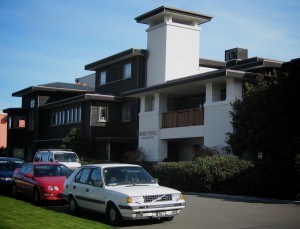The Anim-FX conference was recently held in Wellington. New Zealand has transformed its industry over the last 10 years and in conjunction with the VES, this conference provided a great platform for the local post and vfx industry.
We were recently in New Zealand for the Anim-FX conference. While certain aspects of the conference were great, overall a huge number of featured speakers cancelled and the event suffered as a result. The highlight had to be senior vfx artist and matte painter Harrison Ellenshaw. Harrison is a master in his own right, having worked on films from Star Wars to Tron, he is also the former head of Buena Vista Visual Effects. If his career was not impressive enough, his father, Peter Ellenshaw, was a master matte painter winning the Oscar for Mary Poppins. We will feature an exclusive interview with Harrison in an up coming fxguidetv episode.

A second favorite for me personally was a very strong series of sessions on the opening day covering work done at Park Road Post – including the release of their recipe for Park Road’s famous Crab cakes – see below. One area we were keen to investigate was the Park Road Post RED image post processing – noise reduction. In a test done for a major RED feature recently – Park Road Post clearly won with a cleaner and better film output than any other company. The rumor was that they were doing a clever piece of maths to lift information from the green and red channels to decrease the noise in the blue channel. Adam Scott, Head of DI at Park Road Post, denied this when we asked point blank about it, pointing to a series of smaller improvements and attention to detail from .r3d conversion to release print, that led to the collective improvement seen by film makers on screen when Park Road Post projects their material.
Park Road Post is located in Wellington, and boasts production offices, private rooms, 3 apartments, a cafe, gym, cinema, 600 sq. ft. foley stage, sound facility, HD and SD, telecine, a film lab, editing and post suites. The suites include multiple Quantel DI Pablos, Barco projectors, 132 Terrabytes of online storage, Arriscanners and Arrilaser film recorders, plus the usual FCP/Shake/Maya/AE, roto stations and 18 dry hire suites. It now has 70 staff members and really has established itself as one of the premier post facilities in the Southern Hemisphere. Also on the panel with Scott was Katie Fellion of Plaster City (who we’d like to have heard more from), the very talented DOP Richard Bluck, and Lawrence Alexander from Rubber Monkey, who is a an extremely talented and well-informed post production expert. The panel was hosted by Carolyn Giardina.
Lawrence Alexander pointed out that on an Indie film he just budgeted the move from Film to Digital moved the stock/archive cost from $250,000 to $500, and that this alone makes a huge difference to independent film making. He described Rubber Monkey’s solutions as being “like Subway Sandwiches – pick and choose and decide what you like.”
Richard Bluck was very interesting, he was second unit director of photography on King Kong, The Lord of the Rings: The Return of the King, The Lord of the Rings: Two Towers and did the miniatures on Master and Commander. But he was also DOP on Crossing the Line, the first ever short film shot by Peter Jackson on the RED ONE. His stories of shooting Crossing the Line without down convertors, without real tools – all with tanks, planes, explosions, cranes, and steadicam – was most amusing. For example, he was half way through a conversation with Jim Janard about the 10 stops of latitude on the RED ONE when Jim’s phone rings and he is told that software was not loaded and he had only 9 stops. In the end without proper monitoring, said Bluck, ” I relied on someone else to check what I shot, I just took a bet… you can have a tented off black room, but if you want to be part of the creative process you have to be out with your cameras – as a DOP that’s why I often operate…”
But Bluck also joked about having just finished working on Avatar with James Cameron. Cameron is well known to also like to operate his own cameras, so Bluck joked that on the set of Avatar, “I spent a lot of time in the truck with nothing to do.”
In the end on Crossing the Line Bluck decided, “If it is meant to be between HD and film – I figured I would just try and do the same thing I normally do and light it well.” He went on to point out the danger of shooting with colour grading systems on set, saying “before HD it was just a video split and no one cared.” Now he believes people can get too focused on what they are seeing on the split.
While Bluck sees the future of film making as gathering much more data on set and providing more information back to post-production, he also lamented the trend to no longer call ‘cut’ and plan a days shooting, referring to running resets and only stopping for battery changes as leading to younger inexperienced film makers just “hosing down the drama” and filming incredibly high shooting ratios.

He also had very strong admiration for Weta and the Peter Jackson family of film makers. “The way they have pushed film, nothing is unachievable – if we want to get it and we can’t on set then they would just solve it later in post.” Another panelist described the way Weta had now evolved their workflow and own code base to a point that “nothing is off the shelf there anymore – other than the coffee machine.”
Panels also focused on 3D stereo film making. The general opinion seemed to be that 3D was coming, especially to the USA, and yet everyone wants to make the “film making process as economical and as creative as possible”, and that new systems are still being developed to allow for this. Discussion pointed to the crew on Avatar that had not only focus pullers but also interocular pullers per camera and rigs, lenses, and general on set manageability all meant that pre-production was even more important than ever before. Park Road Post’s Adam Scott implied not too subtly that he expected to be doing 3D and that their first big project will be for “someone in the family”. Scott and others pointed to not only the need for pre-production, but much earlier involvement by producers of the post suppliers before shooting. This early involvement is key for both technical and budgetary reasons. Others such as Lawrence Alexander pointed to this just growing even more vital as we all move to digital projection. He summed up the situation and growing flexibility and complexity of digital film making by saying, “In the end it all comes down to the final look you want and what you are prepared to pay to get there.”
Overall the conference was great for the local industry. The audience appeared to be made up of some clients/film makers, a few pure production people/DOPs, and students but mainly post-production people. New Zealand has done nothing short of a miracle in building a world class film and effects industry, for a remote and relatively small country. So much so that it is the envy and model for other non-USA film communities worldwide. It is just bad luck that a series of international speakers cancelled so close to the conference – reducing the talent pool of the speakers to more just local based members of the NZ community, having said that – it is one heck of a local film community!
Park Road’s most valuable trade secrets

Park Road Post Thai Fish Cakes
Recipe for Fish Cakes:
500g of fresh fish filets
2 Tablespoons of fish sauce
1 tablespoon of red curry paste
1 egg
1 tablespoon of palm suger
1/2 cup of thinly sliced green beans
A small bunch of Coriander or Cilanto
Start by chucking the first five things in a blender until they’re smooth, but not too smooth. Dont go overboard unless gran is coming ’round for dinner. Fold in the beans and the Coriander with the kind of care and delicacy you would reserve for potential backers in a funding meeting. Roll into Balls, or to use the technical term ‘cakes’. Fry on high heat until golden brown and serve ’em with good salad and fresh lime.
